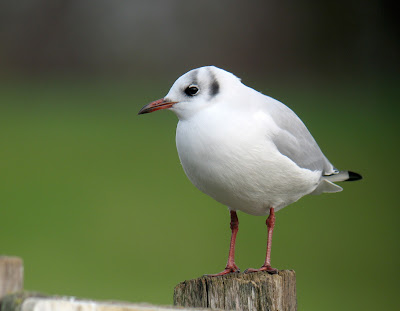Wednesday, 4 January 2012
Black heads
Black-headed Gulls are a familiar sight in Britain with over 200,000 breeding pairs. The bird is named incorrectly, in my opinion as it never actually has a black head. In the summer the adults have a dark chocolate hood and in the winter months (as in the photos above) it has a white head due to the hood being moulted. It is a beautiful bird though, with wax red legs and bill and slim, pointed wings with an obvious white stripe along the front edge.
Subscribe to:
Post Comments (Atom)



Wonderful images...
ReplyDeleteI really do struggle with gull ID..
1st winter this 2nd winter that... plumage? Different coloured eyes/legs in juveniles...it's a science all of it's own.
I am trying though.. lol
Nice images and discription John. They are elegant if noisy birds.
ReplyDeleteSome really nice shots here John, that first one is perfection.
ReplyDeleteYes we tend to overlook this species sometimes I think, just because its common. We use to overlook House and Tree Sparrows, now look what has happened.
Hi John,
ReplyDeleteTis a fine looking bird. Perhaps it could be called 'dark chocolate head' in the summer and 'white head', in the winter. Nah, probably too confusing but I see your point in regards to the name.
Thanks for sharing these lovely photos. My apologies for not commenting lately. I hope you had a peaceful Christmas and that 2012 is a most inspirational year for you and your loved ones.
With respect, Gary
Thanks, John. When people become keen birders it's so easy to forget the beauty of everyday species. I often recall sitting in a hide at Cley, a man entered and said "Anything remarkable about" - from the corner a reply came "Sure, they're all remarkable. They can fly and we can't do that!"
ReplyDeleteHi John...I often wonder who,and why birds get there names especially when color is involved ..like the black headed ...like you said hmmm...!!
ReplyDeleteGreat shots..especially like the first on...didn't see any black though ; }
Grace
Hi Andrew,
ReplyDeleteThank you. Gulls are a problem, I don`t have many problems with adults, but when it comes to juv`s, 1st winters etc, it`s a mine-field!
J
Thanks Mike,
ReplyDeleteThey can make a bit of a row can`t they?!
J
Hi Roy,
ReplyDeleteThank you, I am quite pleased with the first one!
We only miss something when it`s gone, but we as humans never seem to learn!
J
Hi Gary,
ReplyDeleteI think that would get a bit confusing! ;)
Apologies are not necessary my friend. I hope you had a peaceful yuletide and have a prosperous New Year.
J
Hi John,
ReplyDeleteYes, I have come across that quite a lot, people asking if anything unusual is about and not bothering to look at the more `common` birds! It gives birdwatchers a bad name!
J
Thanks Grace,
ReplyDeleteYes, I often wonder that too! I know certain names are from the people who first identified the species etc, but as far as coloured heads etc, I haven`t got a clue!
J
When I first photographed some gulls at the seaside I spent ages looking for ones with black heads - very confusing.
ReplyDeleteHi John. I think gulls are easier to identify in the air than on the ground!
ReplyDeleteClick here for Bazza’s Blog ‘To Discover Ice’
Hi John,
ReplyDeleteYes, I remember telling my niece and nephew that the gulls they were looking at were called black-headed ones, they didn`t believe me because they didn`t have black heads!
J
Hi bazza,
ReplyDeleteI don`t know about that, it depends on either view. I find it easier on the deck, but that`s just me!
J